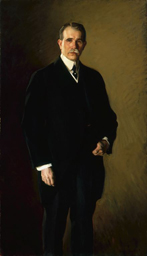Historic Collections: The Mr. and Mrs. Martin A. Ryerson Collection
Learn more about Martin A. Ryerson, one of the Art Institute's founding trustees and an important donor to the museum.
Martin A. Ryerson, one of the Art Institute's founding trustees, was perhaps the single most important donor to the museum's collections as well as the donor of its library. Applying the museum's mission to represent art from all periods and styles to his own collecting practices, he acquired an extraordinary group of works ranging from the classical period to the 20th century, including paintings, sculptures, textiles, prints and drawings, Asian art, and European decorative arts.
Ryerson and his close friend Charles L. Hutchinson, president of the Art Institute's Board of Trustees, frequently traveled together throughout the world, attending art auctions and visiting galleries — always adding to the museum's collections by their own gifts and gaining additional funding from their circle of friends. Although their earliest purchases were in the field of classical art, their interests also included art of their own time, from the Impressionists to Winslow Homer.
After Chicago's 1893 World's Columbian Exposition, which brought Impressionist painting to the attention of many local collectors, Ryerson energetically pursued works by Claude Monet, acquiring more than a dozen paintings, including Arrival of the Normandy Train at the Gare Saint-Lazare, 1877. While visiting the artist at Giverny, France, in 1920, Ryerson even tried to purchase his water-lily murals, but Monet gave the series to the French government instead.
In American art, Ryerson admired the heroism of Homer's The Herring Net, which was shown at the 1893 exposition in Chicago. Ryerson purchased the work in 1915. He was fascinated with John Singer Sargent's loose brushwork in Venetian Glass Workers, and he also acquired numerous paintings by the early American modernist Arthur B. Davies.
Most of the collection of Mr. and Mrs. Martin A. Ryerson came to the museum as a bequest in 1933, the year after Martin Ryerson's death at the age of 75. Mrs. Ryerson donated additional works to the Art Institute (as well as other museums throughout the country) after her death in 1938.
Louis Betts. Martin A. Ryerson, 1913. Mr. and Mrs. Martin A. Ryerson Collection, 1933.1183.


